In this issue:
Basil Downy Mildew
Potato Leaf Hopper
Tortoise Beetle
Early Blight on Tomato
Onion Thrips
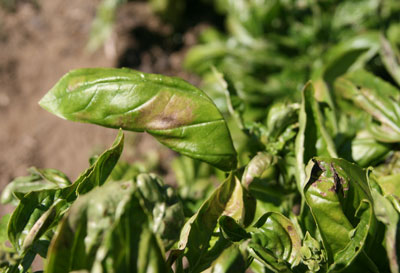 |
| Basil downy mildew on the upper surface of a leaf … |
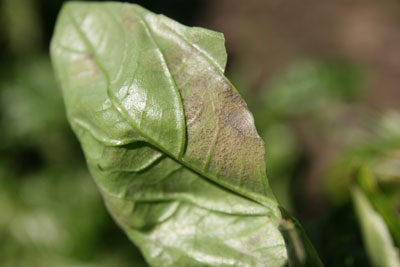 |
| … and on the lower surface. |
BASIL DOWNY MILDEW
I just got from a colleague in New York some pretty bad news that is reminiscent of the 2009 late blight storm. I heard that some of the big chain stores in TN, WI and CT are selling plants already infected with basil downy mildew. I have no local reports yet, so please email me and let me know if you see diseased plants in garden centers in northern New England (see photos). This could be a big problem if the conditions favor spread and survival of spores. Last year basil downy mildew did not arrive here until late summer. Things could be much worse this year.
Basil downy mildew is a new problem for us, but already well established in New England. Downy mildew of basil was first reported in Uganda back in 1930. It has been getting lots of attention as it spreads, first to Italy in 2004, France in 2005, United States (Florida) in 2007 and by 2009 New England. Last year it was all over Maine and New Hampshire.
The first symptom is a pale yellowing of the upper surface of the leaves, quite similar to sunscald. Later, the diagnostic vein-bounded patches of dark spore production can be seen on the lower surface. This develops into a gray, fuzzy growth typical of downy mildews of other crops. At first you may be able to convince yourself that some soil has been splashed onto the underside of the leaf, but soon the plants will be going down and it will be clear that it is not a problem that can be washed away.
Since it is a relatively new problem, there is still lots to learn about it. At this time we know that the disease may be seed borne, but that is probably a very rare event. The spread in most likely do to the wind blown spores. In damp conditions in mid summer spores can move far and wide. Unlike the other downy mildews that we are familiar with, such as lettuce or spinach, basil downy mildew does better in warm weather.
Some types of basil are less or not susceptible at all. For example, Thai basil is fine. I have heard from a grower that the lemon basil is not susceptible, and that the purple basil seems a bit less susceptible. The common sweet basil is the most susceptible. If you have this problem, and you grow more than one type of basil, please keep records and let me know if you see any resistance so we can make some recommendations for next year.
Anything that will make the leaves dry quickly will help, e.g., weed control, good spacing, venting tunnels, watering in the very early morning instead of the early evening, etc. Destroy infected plants to reduce spores blowing in the wind infecting later plantings. Making many successive plantings may increase your chance of avoiding periods of high spore movement.
There are relatively few fungicides labeled for herbs. Also, I have not seen reports of efficacy of any. Some copper fungicides are labeled. Other OMRI listed products that are labeled for herbs include Actinovate AG, Trilogy, and OxiDate. But, again, I do not have any evidence that they are effective. If you try any of these, leave some plants untreated so we can get some information.
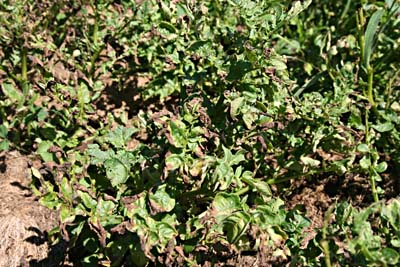 |
| Leafhopper hopperburn on potatoes. |
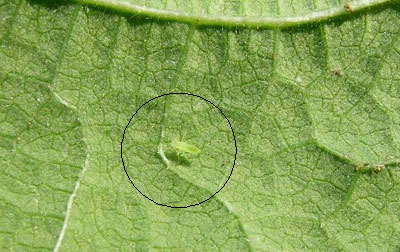 |
| Leafhopper nymph on the underside of a leaf. |
POTATO LEAFHOPPERS
I have received no reports yet, nor seen them in Maine or New Hampshire, but be on the look out for the potato leafhopper (PLH). They primarily feed on beans, potatoes, eggplants, strawberries and alfalfa. PLH does not over winter anywhere near here. They over winter way down south on the coast of the Gulf of Mexico, and leapfrog up here in mass migrations. Sometimes hardly any make it, and other years there are massive numbers. Once they get here there are a few generations during the season and often become a bigger and bigger problem. The first to arrive are females, and they are usually carrying fertilized eggs when they get here. They first land in trees and were spotted last week in western Massachusetts.
The damage from leafhopper is catastrophic. The bug sucks the juice out of the plant and injects a toxin that clogs the food conducting tissue. The symptoms look like a disease after a while, rather than insect damage, and is frequently mistaken as such. The leaves first get pale, then yellow and then brown from the edges. Then the plant dies. The symptoms are called hopperburn.
The adult PLH is very light green and wedge shaped and tiny (an eighth of an inch long). The best way to find them is to brush the plant, see a bunch of this tiny things fly up, and watch one of the white-looking bugs land. The nymphs are similar to the adult, but have no wings and are even smaller. Nymphs live on the underside of the leaves. If you disturb a nymph you will see it run and it can run sideways as fast as forward. This is a clue that you have PLH and not some other less harmful species of leafhopper.
The adults are flighty. When you brush your crop you will see them fly up. If there is a cloud of them, you are in trouble. Researchers have developed a threshold before treatment is recommended. Thresholds vary but here is one that is typical: Treat potatoes if 5 adults or 15 large larvae are found on 50 leaves.
Crop rotation does nothing for you since they are coming from far away. Covering your crops with a row cover would work, but these crops are not the type that are usually covered. Effective insecticides are limited. The only material that I have seen work that is allowed in organic production is pyrethrum, so Pyganic is the recommendation that I make. However, it does not work as well as a pyrethrum with PBO, BUT PBO is not permitted in organic production. If you market crops as organic, be sure to use an approved brand. Use the most concentrated mix allowed by the label. Spray late in the day or evening, get good coverage including the undersides of the leaves, and don’t wait until it is too late. If you wait to see damage, it is too late. Plants will not recover.
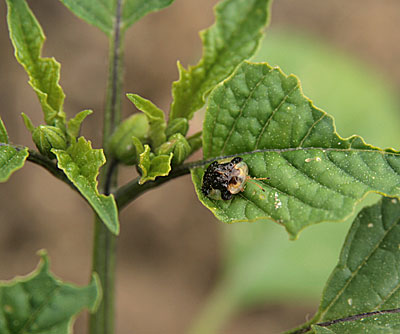 |
| Tortoise beetle |
TORTOISE BEETLE
This used to be a rare pest but again this year I am getting many calls about them. Still, I do not believe that they do serious damage and do not warrant spraying. The numbers are usually very small and the beetles can be hand picked off. Of course, this could change. There is a tortoise beetle that feeds on sweet potatoes down south that is quite a serious pest.
They are oval to a square shape, clear to metallic looking with a dark square marking on the center of their back. Once you see one you will remember it (see photo). There are a few species of tortoise beetles. The one I am getting the most calls about is feeding on eggplants, tomatillos, peppers and potatoes. They overwinter as adults and come out in the mid spring. They eat holes in the leaves. When in small numbers, I recommend ignoring them or hand picking them off. If you have them in large numbers, please let me know.
EARLY BLIGHT ON TOMATO
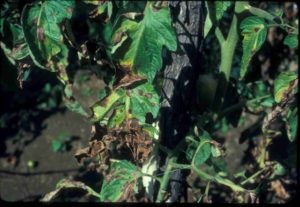  |
| Early blight on tomato |
Although not a problem yet, it is time to think about early blight. Early blight is caused by two fungi that are serious problems in tomatoes and potatoes, but rarely affect peppers and eggplants. In most years, it is a much more common problem than late blight, probably the most common problem of garden tomatoes. All aboveground portions of the plant can be affected throughout the growing season. The disease starts on the lower leaves with small, circular spots that resemble a target with their concentric rings. Leaves develop yellow blighted areas, eventually turn all yellow and die. The tomato fruit may rot on the stem end. Though rare, potato tubers can also become infected. The pathogen overwinters on diseased plant residues in the soil. Initial infection is from splashing up from this overwintering site. By mid summer, most of the infection is coming from spores blowing in the wind from widespread infection in gardens and on farms across the region. It is important to avoid early on set of the disease because the longer you can avoid the problem the more likely it is that you will harvest red tomatoes before the plants die. Here are some cultural practices that can help avoid this disease.
Early blight on tomato
Use crop rotations of at least three years to non-hosts (i.e., away from tomato, potato, and eggplant). Once the plant residue decays, the pathogen is gone.
Provide optimum growing conditions and fertility. Stressed plants (including drought or excessive moisture or shade) are more susceptible to early blight.
Stake or cage plants to keep fruit and foliage away from soil, and promote quicker drying.
Drip irrigation is preferred. If using overhead irrigation, start before dawn, so plants are dry early in the day. The key is to keep the period of leaf wetness to a minimum.
Mulching helps to prevent splashing of spores from soil up to lower leaves.
Indeterminate tomato and late-maturing potato varieties are usually more resistant or tolerant to early blight.
Early blight can be seed-borne, so buy from a reliable supplier. Hot water seed treatment at 122 degrees F for 25 minutes is recommended to control early blight on tomato seed.
Each season, disinfect stakes or cages with an approved product before use. Sodium hypochlorite at 0.5% is effective and must be followed by rinsing and proper disposal of solution. Hydrogen peroxide is also effective.
Grow tomatoes in a high tunnel or caterpillar tunnel. Tomatoes grown with such protection rarely suffer from early blight because there is less splashing and wind blown spores and the leaves are drier.
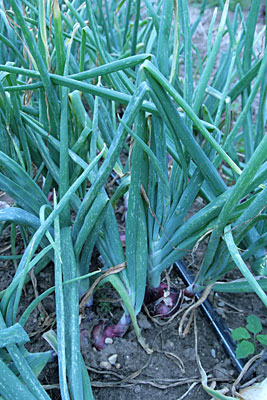 |
| Damage to onion leaves caused by thrips. |
ONION THRIPS
Onion thrips activity is being reported just south of us, and if they have been a problem for you in years past it is time to start scouting for them. They are very tiny and easily overlooked until the onion plants start showing leaves that look as if they have been rasped. In fact they have. The thrips feed by using their moth parts to rasp and pierce the onion leaves, releasing juices for them to feed upon. If the population of thrips is large you will see silvery patches on all the young leaves and when really bad the whole field will look white and silvery and the leaves wither. Obviously onion yields can be greatly reduced because the onion plants loses food and water through the damaged tissue. It is best to get control of them now before the populations grow.
Onion thrips hide between the leaves at the base of the onion plant. I find the best way to find them is to pull up a plant and hold it upside down over a white sheet of paper and pull apart the leaves as you shake gently. Even when they are walking about on the paper you will still need to look hard to see the thrips. My eyes are not that good and I need a hand lens to even spot them. The immature thrips are white to a pale yellow, elongated with very short antennas and dark eyes. Remember, tiny. The adult is tiny too, but it has wings. Thrips’ wings are unique. They are fringed with hairs. Thrips are very poor fliers, but they do fly when disturbed, and they do get blown in the wind easily. Keep in mind that this means thrips will be blown to new fields downwind. Adults are pale yellow to dark brown.
There are many generations per season and they can be very quick in warm weather. Also, parthenogenesis is common, meaning females that cannot find males produce progeny all by themselves. Each female can produce up to 80 eggs, which tells you that the population can explode quite quickly under good conditions. Good conditions are warm and without heavy rains. Heavy rains wash the weak insect off the plant.
Growers can simulate heavy rains with heavy overhead irrigation. As well as disturbing the insect, the extra water will help the rasped onions. Extra fertilization will help too.
Thrips survive in onion and garlic debris so clean up after harvest. I have heard that thrips are confused by inter-cropping with carrots.
If the natural enemies or the cultural practices fail to keep thrips populations down then you may need to turn to a pesticide. Remember, thrips are often around in small numbers that can be tolerated. IPM practices recommend an economic threshold of an average of 3 thrips per green leaf. When scouting, sample about 50 plants around the field from at least 10 different locations in the field and then figure the average per leaf. Spinosad (Entrust or Monterey Garden Spray) is the most common recommended material for organic growers. Follow the label instructions and be sure to spray into the leaf axis. Surround is reported to deter thrips, and may be the better choice if you have had bad thrips problems in the past. See the summer 2013 issue of The MOF&G for an excellent article about thrips by Tom Vigue.
